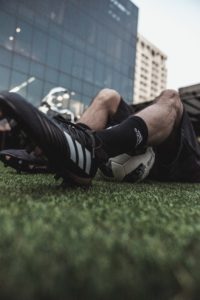
Blisters on the feet are one of the most common foot injuries in sport and in everyday activities. They can be quite mild and not causing any issues, but can also be very painful and stopping you from doing your sports and activities.
This guide will give you advice to treat a painful blister and how to prevent them in the first instance.
The treatment for blisters depend at what stage the blister is at.
- Intact blisters – if the roof of the blister is intact and it has not burst, use a protective dressing such as cutiplast on it, anything with an absorbent pad on it and sticky tape on all sides will be sufficient, you dont want to put anything that sticks directly on the blister! This will protect the blister and while its still intact infection cannot get in!
- Torn blisters – this is where the roof of the blister is broken but hasnt completely de-roofed. It is now open to infection and you will need to use an antiseptic spray to keep it clean such as Betadine Spray and apply a padded dressing on it until it heals and to prevent the roof of the blister from completely torn off.
- De-roofed blisters – this is where the roof of the blisters have been completely torn off (de-roofed) and the result is a very raw and sore area of injury to the skin. It is more open to infection at this stage and will take longer to heal. At this stage you will need a type of dressing called hydrocolloid dressing such as Compeed which is waterproof and does not need changing daily. These type of dressings interact with your raw blister and stimulate healing from the outside-in. If your blister is very weepy then a more absorbent dressing like Cutiplast or melolin is more appropriate and change it daily until it stops weeping.
SHOULD I POP A BLISTER:
The answer to this depends depends on:
- size and location of the blister
- your circumstances at the time ( at home, on a hike, feet clean or dirty? etc ), your general health, your access to medical help
Generally speaking if a blister is not painful and not at risk of being torn off by your activity then protect it and let it heals naturally. If it is painful and you either have access to help or the right gear such as sterile dressings and blades, antiseptic etc.. then draining it will help to relieve the pain. If you are diabetic or are immuno-compromised then you should always seek help from a health care professional in the first instance.
HOW TO PREVENT BLISTERS
Blisters are caused by shearing stress on your skin. By making an area where your skin is prone to develop blisters more slippery, you can reduce the stress on your skin. So an application of something like Vaseline to just the area where your skin is prone to develop blisters before your activities can be helpful. The use of an astringent such as surgical spirit regularly can help to toughen up your skin thereby enabling it to withstand more shearing stress can be helpful. Correct fitting shoes and correct lacing techniques (see the share link below for a YouTube video of how to do this) which helps to hold your feet firmly inside the shoes will help. Double or thicker socks can also be helpful. Poor mechanic of your feet can lead to uneven pressure distribution, visit a Podiatrist to have your gait assess properly in this instance.

